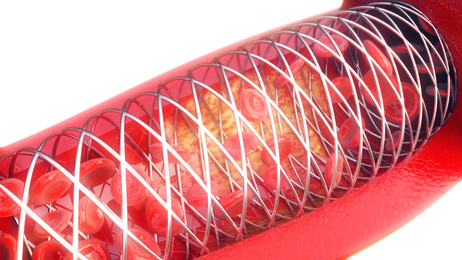In stent restenosis (ISR) continues to be the main limitation to the percutaneous treatment of coronary artery disease, with 5 to 10% prevalence after new generation DES stenting. Guideline recommendations for this intervention include new DES stenting and the use of drug coated balloons (DCB). Recurrent ISR stenting rate ranges between 10 and 40%, and its treatment remains challenging.

The aim of this post hoc analysis of the randomized ISAR-DESIRE 3 (Efficacy Study of Paclitaxel-Eluting Balloon, -Stent vs. Plain Angioplasty for Drug-Eluting Stent Restenosis) was to look into post DES stenting recurrent revascularization incidence at long term.
Primary end point was repeat target lesion revascularization (R-TLR), defined as any repeat revascularization: either with balloon (PCI) or CABG after recurrent ISR.
At 10 year followup, total R-TLR was 373: 162 occurred in the plain balloon angioplasty (PB) group, 124 in the drug coated balloon (DCB) group and 87 in the DES stenting group. During the first year, the risk of R-TLR was reduced with DCB (HR: 0.36; CI 95%: 0.24-0.54) and DES (HR: 0.23; CI 95%: 0.14-0.38) vs. PB.
Read also: Short-Term Outcomes of TAVR in Asymptomatic or Minimally Symptomatic Patients.
After year 1, R-TLR risk saw a significant reduction with DCB (HR: 0.77; CI 95%: 0.51-1.16) and DES (HR: 0.61; CI 95%: 0.39-0.95). Risk for DCB and DES was similar during (HR: 1.54; CI 95%: 0.89-2.69) and after (HR: 1.26; CI 95%: 0.82-1.92) the first year.
Conclusión
Total R-TLR at 10 years was high. The use of DCB and DES reduce the need for primary and recurrent revascularization vs. plain balloon angioplasty.

Dr. Andrés Rodríguez.
Member of the Editorial Board of SOLACI.org.
Original Title: Recurrent Revascularization at 10 Years After Percutaneous Treatment of Drug-Eluting Stent Restenosis.
Reference: Tobias Koch, MD et al J Am Coll Cardiol Intv 2024;17:1–13.
Subscribe to our weekly newsletter
Get the latest scientific articles on interventional cardiology





